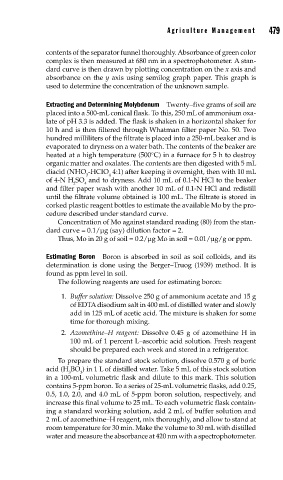Page 507 - Biosystems Engineering
P. 507
Agricultur e Management 479
contents of the separator funnel thoroughly. Absorbance of green color
complex is then measured at 680 nm in a spectrophotometer. A stan-
dard curve is then drawn by plotting concentration on the x axis and
absorbance on the y axis using semilog graph paper. This graph is
used to determine the concentration of the unknown sample.
Extracting and Determining Molybdenum Twenty–five grams of soil are
placed into a 500-mL conical flask. To this, 250 mL of ammonium oxa-
late of pH 3.3 is added. The flask is shaken in a horizontal shaker for
10 h and is then filtered through Whatman filter paper No. 50. Two
hundred milliliters of the filtrate is placed into a 250-mL beaker and is
evaporated to dryness on a water bath. The contents of the beaker are
heated at a high temperature (500°C) in a furnace for 5 h to destroy
organic matter and oxalates. The contents are then digested with 5 mL
diacid (NHO -HCIO 4:1) after keeping it overnight, then with 10 mL
3 4
of 4-N H SO and to dryness. Add 10 mL of 0.1-N HCl to the beaker
2 4
and filter paper wash with another 10 mL of 0.1-N HCl and redistill
until the filtrate volume obtained is 100 mL. The filtrate is stored in
corked plastic reagent bottles to estimate the available Mo by the pro-
cedure described under standard curve.
Concentration of Mo against standard reading (80) from the stan-
dard curve = 0.1/μg (say) dilution factor = 2.
Thus, Mo in 20 g of soil = 0.2/μg Mo in soil = 0.01/μg/g or ppm.
Estimating Boron Boron is absorbed in soil as soil colloids, and its
determination is done using the Berger–Truog (1939) method. It is
found as ppm level in soil.
The following reagents are used for estimating boron:
1. Buffer solution: Dissolve 250 g of ammonium acetate and 15 g
of EDTA disodium salt in 400 mL of distilled water and slowly
add in 125 mL of acetic acid. The mixture is shaken for some
time for thorough mixing.
2. Azomethine–H reagent: Dissolve 0.45 g of azomethine H in
100 mL of 1 percent L–ascorbic acid solution. Fresh reagent
should be prepared each week and stored in a refrigerator.
To prepare the standard stock solution, dissolve 0.570 g of boric
acid (H BO ) in 1 L of distilled water. Take 5 mL of this stock solution
3 3
in a 100-mL volumetric flask and dilute to this mark. This solution
contains 5-ppm boron. To a series of 25-mL volumetric flasks, add 0.25,
0.5, 1.0, 2.0, and 4.0 mL of 5-ppm boron solution, respectively, and
increase this final volume to 25 mL. To each volumetric flask contain-
ing a standard working solution, add 2 mL of buffer solution and
2 mL of azomethine–H reagent, mix thoroughly, and allow to stand at
room temperature for 30 min. Make the volume to 30 mL with distilled
water and measure the absorbance at 420 nm with a spectrophotometer.

